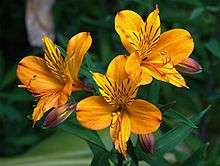Alstroemeriaceae
Alstroemeriaceae is a family of flowering plants, with 254 known species in four genera (Christenhusz & Byng 2016 [2]), almost entirely native to the Americas, from Central America to southern South America. One species of Luzuriaga occurs in New Zealand, and the genus Drymophila is endemic to south-eastern Australia.
| Alstroemeriaceae | |
|---|---|
 | |
| Alstroemeria aurea in cultivation | |
| Scientific classification | |
| Kingdom: | Plantae |
| Clade: | Tracheophytes |
| Clade: | Angiosperms |
| Clade: | Monocots |
| Order: | Liliales |
| Family: | Alstroemeriaceae Dumort.[1] |
| Type genus | |
| Alstroemeria | |
| Genera | |
|
See text | |
The genus Alstroemeria, commonly called the Peruvian lilies, are popular florist's and garden flowers. The genus Bomarea is a vine that produces clusters of variously-colored, bell-shaped flowers.
Classification
The APG II system, of 2003 (unchanged from the APG system, of 1998), treats the family in the order Liliales, in the clade monocots. The APG III system, of 2009, merged the obscure family Luzuriagaceae into the Alstroemeriaceae, since the former group included only two genera, was the sister group of the Alstroemeriaceae, and possessed the same distinctive twisted petioles.
- Tribe Alstroemerieae
- Tribe Luzuriageae
Distribution
Alstroemeriaceae is distributed in tropical and temperate America, from Mexico and the Antilles to Tierra del Fuego. Luzuriageae is distributed from Peru to the Falkland Islands and Tierra del Fuego, New Zealand and Australia (NSW to Tasmania).
Uses
As food
Bomarea edulis is distributed from Mexico to Argentina. Its tubers have been used from pre-Columbian times as a food source. A single plant can have up to 20 tubers each 5 cm in diameter.
As ornamental plants
Some of the Alstroemeriaceae species used for ornamental purposes are:
- Alstroemeria aurea: endemic to Southern Chile. Flowers in the summer. Flowers are 3–4 cm in diameter, they're yellow and orange, tinged with green.
- Alstroemeria haemantha: endemic to Chile, especially near Valparaíso. It grown near rocks and flowers at the beginning of summer. It has red flowers that can grow up to 5 cm in diameter. Florece a principios de verano.
- Alstroemeria ligtu: endemic to Chile, it grows in stoney, sand, dry soil. It flowers at the end of spring and the beginning of summer and has a height of 60 cm–1 m. Its flowers present several colours, usually lilac and pink, red or white.
- Alstroemeria psittacina: distributed in the Brazilian swamp, Peru and the Misiones Province in Argentina. Its flowers have a length of 4–5 cm, and grow in bunches of 5 to 6 flowers. Its petals are red and green.
- Bomarea ovallei (syn.: Leontochir ovallei): endemic to Chile, grows in stoney soil in full sunlight in the 3rd Region of Chile. It has red flowers, which can also be yellow, although rarely. They can have a diameter of up to 10 cm. It is an endangered species due to its modest distribution and its use as food by wild animals.
Other species, such as Luzuriaga radicans, also endemic to Chile, have potential as ornamental plants.
Bibliography
- Anton Hofreiter & R. E. Rodríguez: The Alstroemeriaceae in Peru and neighbouring areas, in Revistá Biología Peruana, 13 (1), 2006, p. 1-62.
References
- Angiosperm Phylogeny Group (2009), "An update of the Angiosperm Phylogeny Group classification for the orders and families of flowering plants: APG III", Botanical Journal of the Linnean Society, 161 (2): 105–121, doi:10.1111/j.1095-8339.2009.00996.x, archived from the original on 2017-05-25, retrieved 2010-12-10
- Christenhusz, M. J. M.; Byng, J. W. (2016). "The number of known plants species in the world and its annual increase". Phytotaxa. Magnolia Press. 261 (3): 201–217. doi:10.11646/phytotaxa.261.3.1.
- Aagesen, L.; A. M. Sanso. (2003). "The phylogeny of the Alstroemeriaceae, based on morphology, rps16 intron, and rbcL sequence data". Syst. Bot. 28 (58).
- Sanso, A. M.; C. C. Xifreda (1997). "A morphological and taxonomic appraisal of the monotypic South American genus Schickendantzia (Alstroemeriaceae)". Scripta Bot. Belgica. 15 (139).
- Chacón, J.; M. Camargo de Assis; A. W. Meerow & S. S. Renner (2012). "From east Gondwana to Central America: Historical biogeography of the Alstroemeriaceae". Journal of Biogeography. 39 (10): 1806–1818. doi:10.1111/j.1365-2699.2012.02749.x.
External links
- Alstroemeriaceae in L. Watson and M.J. Dallwitz (1992 onwards), The families of flowering plants.
- NCBI Taxonomy Browser
- links at CSDL, Texas
- Alstroemeriaceae in BoDD – Botanical Dermatology Database
 Bomarea sp. in southern Ecuador
Bomarea sp. in southern Ecuador
| Wikimedia Commons has media related to Alstroemeriaceae. |
| Wikispecies has information related to Alstroemeriaceae |